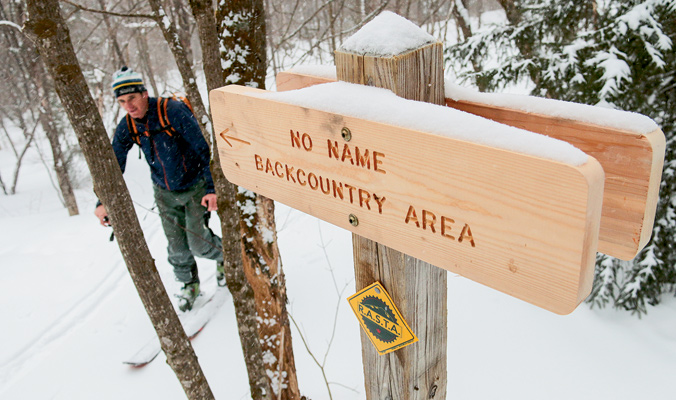Holly Knox has been managing recreational opportunities as a Green Mountain National Forest District Recreation Program Manager for the last decade, a time when the number of backcountry skiers seemingly multiplied overnight. With 400,000 acres of national forest stretching through central and southern Vermont, and many different groups vying for space to recreate, Knox has plenty of work cut out for herself, focusing her efforts on the Rochester and Middlebury Districts. But after spearheading the country’s first backcountry ski zone of its kind, she clearly has it all under control. Here’s what Knox had to say about her recent effort with Vermont’s glades.

RASTA president Angus McKusker disappears into No Name Bowl in the recently created Brandon Gap zone for which he and his organization advocated and developed. [Photo] Brian Mohr
As a recreation manager and a public servant, I’m driven to provide opportunities for people to connect with their public lands; it’s important that locals and visitors know what’s in their backyard. I’m determined to connect people with the outdoors, and recreation is an exceptional conduit to do that.
Another core value of mine is balancing recreation opportunities with sustainable resource management. That is the core of our agency’s mission, which means educating the public, knowing where to locate or not locate a project and how to scale various opportunities.
When backcountry skiing was growing, we weren’t managing areas of the Green Mountain National Forest (GMNF) specifically for skiing, and the user group wasn’t organized enough yet to work with us directly, so we saw unauthorized cutting. Over the past decade, we have been monitoring several locations for unauthorized cutting. Cutting incidents throughout Vermont range from minimal clipping and limbing of vegetation to significant cutting and trespass issues, which have considerable ecological and social impacts, like long-term changes in forest condition or fragmentation of habitats.
This unauthorized cutting absolutely led to the development of the Brandon Gap Backcountry Recreation Area. We have a very small staff and have found that we’re really more effective in reducing illegal activities when we work collaboratively and provide opportunities for those activities on federal lands.
GMNF is a small national forest that relies on our partner community. We were constantly telling people we needed an organized group, people who would share the same core values, the same ethics and who would spread that message and provide volunteers to help us maintain these recreation areas. Locals started coming together and formed the Rochester/Randolph Area Sports Trail Alliance (RASTA). In turn, RASTA helped form the Vermont Backcountry Alliance, which falls under the Catamount Trail Association, whom we have a long history of working with. We have all grown together and learned how we can manage and incorporate different forms of backcountry skiing into our partnership.
We told RASTA to submit a proposal outlining where people would be skiing and what places would be best suited for the activity. Brandon Gap was one of the suggested areas; it met our needs, and it wasn’t displacing any other users in that season.
Once a decision was made to move forward, we worked closely with RASTA. They had a phenomenal outpouring of volunteers that made the project a possibility; they deserve a huge amount of credit.
Neil Van Dyke [Search and Rescue Coordinator for the Department of Public Safety] was a phenomenal resource for outlining the safety considerations of Brandon Gap, and Hardy Avery did an amazing job as the trailbuilder. He was crucial in helping us meet certain measures, such as the line width or certain species we wanted to avoid cutting, and aided our project in being better received by people who had concerns with vegetation management.
I don’t want to say it’s the first time the Forest Service has ever managed in this way, but we did not find other examples of this level of management for backcountry skiing. Knowing that, we made sure that we were organized, could answer questions about the project and felt good about the work being done. I’m proud of this project and the willingness of my boss and the forest supervisor to be innovative and collaborative.
After moving through the process of Brandon Gap, I hope to see a more educated public in the future. I would really like to see the community come to terms with the impacts of cutting, but I also want to see a user group that continues to stay engaged and organized. Backcountry skiers have come to value the relationship with public land managers, and that can come with more secure and sustained recreation opportunities. That’s really important to me, that user groups start to value what public lands can offer.











Looks and sounds incredible. I’m a park ranger as well, so I know how motivated you had to be and how lucky you are to have management support. Very very cool! Where I’m at, rock climbing in the backcountry is what we offer, and having any support from above pertaining to trail building or rehabilitating and or access is non-existent. Hopefully I can play there one day. You are hard as ice!!!